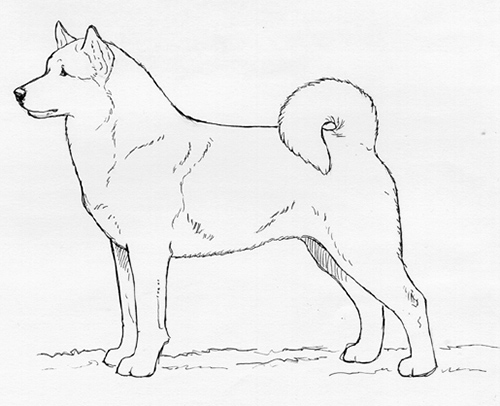Hokkaido (Ainu)
Northern Breed Group
The goals and purposes of this breed standard include: to furnish guidelines for breeders who wish to maintain the quality of their breed and to improve it; to advance this breed to a state of similarity throughout the world; and to act as a guide for judges.
Breeders and judges have the responsibility to avoid any conditions or exaggerations that are detrimental to the health, welfare, essence and soundness of this breed, and must take the responsibility to see that these are not perpetuated.
Any departure from the following should be considered a fault, and the seriousness with which the fault should be regarded should be in exact proportion to its degree and its effect upon the health and welfare of the dog and on the dog’s ability to perform its traditional work.
History
The Hokkaido is said to have originated from medium sized Japanese dogs that accompanied migrants from the main island of Japan to Hokkaido during the Kamakura era, which was in the 1140’s. When the breed was designated as a National Monument in 1937, it took the name of the region. It also became known as the Ainu-ken because the Ainu people, who were the former residents of Hokkaido, were said to have bred the dogs to hunt bear and other animals.
The Hokkaido was recognized by the United Kennel Club as the Ainu January 1, 1996, and the breed name was changed to Hokkaido in 2008.
General Appearance
The Hokkaido is a medium sized, spitz type breed that has strongly developed secondary sex characteristics. It is well balanced, sturdily built and strongly boned. The breed is capable of withstanding severe cold and heavy snowfall. Its tough, clean cut muscles give it great stamina.
Faults: Secondary sex characteristics not well defined.
Characteristics
The Hokkaido is a dog with great dignity. It has a faithful, docile, alert and bold temperament.
Head
SKULL
The skull is broad and slightly flat. It is approximately the same length as the width of the head at the cheeks. There is a shallow, but defined, stop.
MUZZLE
The muzzle is wedge shaped, with a straight nasal bridge. It is about two-thirds the length of the skull. The lips are tight and have black edges.
TEETH
The Hokkaido has a complete set of evenly spaced, white teeth meeting in a scissors bite.
Faults: Slightly overshot or undershot bite.
Disqualification: Extremely overshot or undershot bite.
NOSE
The nose is black, except in white colored dogs, where a flesh colored nose is allowed.
EYES
The eyes are relatively small, nearly triangular in shape, set well apart, and dark brown in color.
EARS
The small, erect ears are triangular in shape and inclined slightly forward.
Disqualification: Ears not prick.
Neck
Powerful and muscular, with no dewlap.
Forequarters
The shoulders are moderately sloping.
FORELEGS
The legs are straight and clean cut, with good bone and slightly sloping pasterns.
Body
In proportion, the Hokkaido is slightly longer than tall in a ratio of 11:10. The chest is deep and moderately broad, with a well developed forechest. The ribs are well sprung. The withers are high and the back is straight and strong. The loin is moderately broad and muscular and the croup is slightly sloping. There is a good amount of tuck up.
Hindquarters
The hindquarters are powerful, with strong hocks.
Feet
The feet have close, well arched toes and hard, elastic pads. The nails are hard and dark in color.
Tail
The tail is set on high. It is thick and carried over the back in a curl or in sickle shape. The tip nearly reaches the hocks when the tail is let down.
Disqualifications: Hanging or short tail.
Coat
Double, with a harsh, straight outer coat and a soft, dense undercoat. The hair on the tail is fairly long and stands off in a brush.
Color
Sesame (red fawn hairs with black tips), brindle, red, black, black and tan or white.
Height
Height at the withers for males is 19 to 20.5 inches. For females, it is 18 to 19 inches.
Gait
At a trot, the gait is active, light and quick.
Disqualifications
(A dog with a Disqualification must not be considered for placement in a conformation event, and must be reported to UKC.)
Unilateral or bilateral cryptorchid.
Viciousness or extreme shyness.
Albinism.
Extremely overshot or undershot bite.
Ears not prick.
Hanging or short tail.

Looking for a Dog?
Find a dog that will fit your family.
Note: The breeders on this list are not endorsed by UKC.
©Copyright 1996, United Kennel Club
